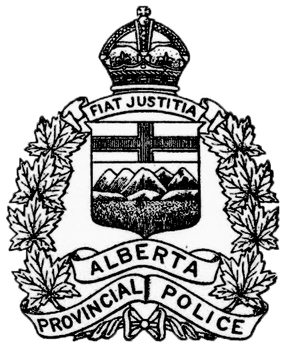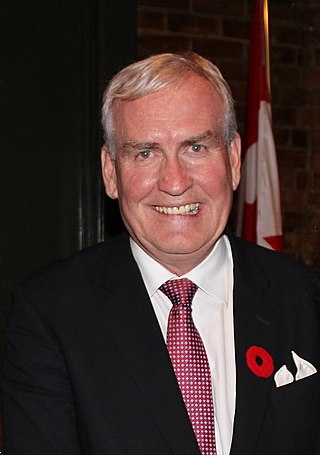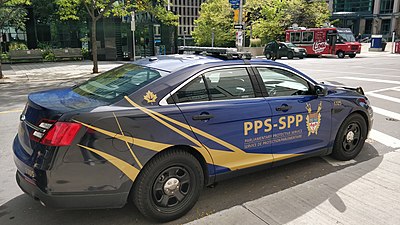
The Royal Canadian Mounted Police is the national police service of Canada. The RCMP is an agency of the Government of Canada; it also delivers police services under contract to 11 provinces and territories, over 150 municipalities, and 600 Indigenous communities. The RCMP is commonly known as the Mounties in English.

The Parliament of Canada is the federal legislature of Canada, seated at Parliament Hill in Ottawa, and is composed of three parts: the King, the Senate, and the House of Commons. By constitutional convention, the House of Commons is dominant, with the Senate rarely opposing its will. The Senate reviews legislation from a less partisan standpoint and may initiate certain bills. The monarch or his representative, normally the governor general, provides royal assent to make bills into law.

Parliament Hill, colloquially known as The Hill, is an area of Crown land on the southern bank of the Ottawa River in downtown Ottawa, Ontario, Canada. It accommodates a suite of Gothic revival buildings whose architectural elements were chosen to evoke the history of parliamentary democracy. Parliament Hill attracts approximately three million visitors each year. The Parliamentary Protective Service is responsible for law enforcement on Parliament Hill and in the parliamentary precinct, while the National Capital Commission is responsible for maintaining the nine-hectare (22-acre) area of the grounds.
A serjeant-at-arms or sergeant-at-arms is an officer appointed by a deliberative body, usually a legislature, to keep order during its meetings. The word "serjeant" is derived from the Latin serviens, which means "servant". Historically, serjeants-at-arms were armed men retained by English lords and monarchs, and the ceremonial maces which they are associated with were originally a type of weapon.

The speaker of the House of Commons is the presiding officer of the lower house of the Parliament of Canada. A member of Parliament (MP), they are elected at the beginning of each new parliament by fellow MPs. The speaker's role in presiding over Canada's House of Commons is similar to that of speakers elsewhere in other countries that use the Westminster system.

The Tomb of the Unknown Soldier is a tomb situated before the National War Memorial in Confederation Square, Ottawa, Ontario. The tomb is dedicated to Canadian service members, and holds the remains of an unidentified Canadian soldier who died in France during the First World War; selected from a Commonwealth War Grave near Vimy, in the vicinity where the Battle of Vimy Ridge took place.

The Protective Policing Service, operated by the Royal Canadian Mounted Police, provides security details for domestic and foreign VIPs when abroad.

Céline Hervieux-Payette is a former Canadian senator who served as the Leader of the Opposition in the Senate of Canada from 2007 to 2008, the first woman to hold this position. She was previously a Liberal member of Parliament from 1979 to 1984 and a cabinet minister in the government of Pierre Trudeau in the 1980s. She retired from the Senate on April 22, 2016, upon reaching the mandatory retirement age of 75.

The Ottawa Police Service is the municipal police service of Ottawa, Ontario, Canada. The OPS serves an area of 2,790 square kilometres and 1,017,449 people, alongside several other police forces which have specialized jurisdiction.

The Centre Block is the main building of the Canadian parliamentary complex on Parliament Hill, in Ottawa, Ontario, containing the House of Commons and Senate chambers, as well as the offices of a number of members of parliament, senators, and senior administration for both legislative houses. It is also the location of several ceremonial spaces, such as the Hall of Honour, the Memorial Chamber, and Confederation Hall.

Law enforcement in Canada is the responsibility of police services, special constabularies, and civil law enforcement agencies, which are operated by every level of government, some private and Crown corporations, and First Nations. In contrast to the United States or Mexico, and with the exception of the Unité permanente anticorruption in Quebec and the Organized Crime Agency of British Columbia, there are no organizations dedicated exclusively to the investigation of criminal activity in Canada. Criminal investigations are instead conducted by police services, which maintain specialized criminal investigation units in addition to their mandate for emergency response and general community safety.

The Alberta Provincial Police (APP) was the provincial police service for the province of Alberta, Canada, from 1917 to 1932. The APP was formed as a result of the Royal North-West Mounted Police (RNWMP) leaving the prairie provinces during the First World War due to a lack of sufficient resources in light of its increased responsibilities for national security and reluctance to again enforce Prohibition law recently put into effect by the Alberta government after its experience doing so during territorial times. The RNWMP was replaced by the newly created Alberta Provincial Police on March 1, 1917, which remained responsible for provincial policing until 1932, when it was eliminated as a cost-cutting measure during the Great Depression. The APP was known for its tumultuous beginning, battles against rum-runners and bootleggers during prohibition in Canada and the United States, as well as its remarkable efficiency and professionalism which endeared the force to Albertans.
The Saskatchewan Provincial Police was a police force in the Canadian province of Saskatchewan that existed from 1917 until 1928 under the Saskatchewan Provincial Police Act.

The decades following the Rebellions of 1837–1838 marked the start of intelligence services in Canada. Defeat in the failed uprising caused the restoration of colonial regimes and the reform of imperialism. As a result, informal intelligence services were formed to conduct certain activities. 1864 marked the formation of two secret police forces and the formal intelligence service in Canada. Created to protect the Canada–United States border, these organization were under the control of a Montreal police commander and political ally. In response to a number of raid and attacks connected with Irish nationalism, Prime Minister John A. Macdonald merged the two forces to form the Dominion Police (DP). The DP was subsequently merged with the North-West Mounted Police to form the Royal North-West Mounted Police in 1904 and the Royal Canadian Mounted Police (RCMP) in 1920.

The 2014 shootings at Parliament Hill were a series of shootings that occurred on October 22, 2014, at Parliament Hill in Ottawa. At the National War Memorial, Corporal Nathan Cirillo, a Canadian soldier and reservist on ceremonial sentry duty, was fatally shot by Michael Zehaf-Bibeau. Described as mentally unwell, Zehaf-Bibeau then entered the nearby Centre Block parliament building, where members of the Parliament of Canada were attending caucuses. After wrestling with a constable at the entrance, Zehaf-Bibeau ran inside and had a shootout with RCMP officers. He was shot 31 times by six officers and died on scene. Following the shootings, the downtown core of Ottawa was placed on lockdown and majority of schools in Ottawa were on lockdown while police searched for any potential additional threats.

Kevin Michael Vickers is a Canadian politician, former diplomat, and retired police officer. He served as the leader of the New Brunswick Liberal Association from 2019 to 2020, a retired Canadian diplomat, former Sergeant at Arms and former Royal Canadian Mounted Police (RCMP) officer. He was the Canadian Ambassador to Ireland from 2015 until 2019 and the ninth Sergeant-at-Arms of the House of Commons of Canada from 2006 to 2015.
The 2014 Saint Jean sur Richelieu ramming attack was a terror car ramming that occurred in Quebec on October 20, 2014. Two Canadian Forces members were hit by a lone wolf terrorist, Martin Couture-Rouleau. Warrant officer Patrice Vincent died from injuries, while another soldier was injured, but survived. The RCMP and the Government of Canada has characterized the homicide as a terrorist act by an Islamic State of Iraq and the Levant-inspired terrorist.

Pat McDonell is the Sergeant-at-Arms for the Canadian House of Commons. He first served under, and then took over the duties of Kevin Vickers when Vickers was appointed Canadian Ambassador to Ireland in January 2015, on an interim basis. He was confirmed in this role on July 1, 2019.

The Anti-terrorism Act, 2015, introduced as, and referred to as Bill C-51, is an act of the Parliament of Canada passed by the Harper government that broadened the authority of Canadian government agencies to share information about individuals easily. It also expanded the mandate of the Canadian Security Intelligence Service (CSIS) and was described as the first comprehensive reform of this kind since 2001.
The police in Canada's ranks differ according to the different police forces and depend on different laws at the federal, provincial, and municipal levels.
















